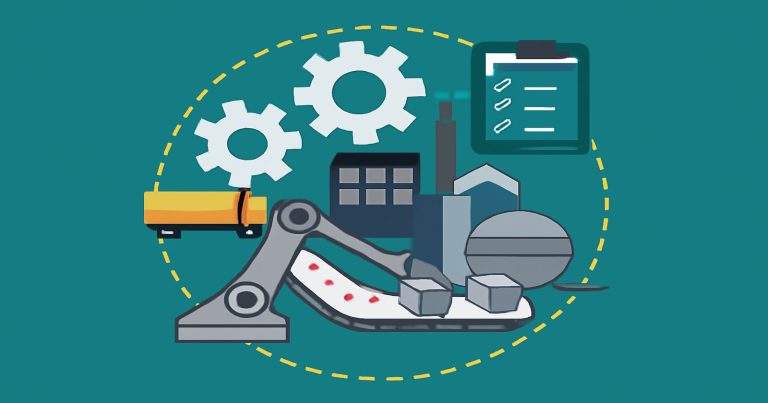The secondary sector of the economy is important since it converts raw materials into finished products and contributes to industrial development and economic growth. The secondary sector comprises such activities as manufacturing, processing, and construction, which bridge the gap between extraction from raw resources and delivery to the market. The secondary sector is important not only in the creation of goods but also as a significant contributor to a country’s gross domestic product and as an employment generator. The secondary sector’s importance in the Indian economy is primarily to serve the driving forces of industrialization, infrastructure development, and improvements in living standards.
What is Secondary Industry?
The industry that falls into the category of a secondary industry is the industry that processes raw materials that are produced by the primary sector into finished goods, semi-manufactured or manufactured goods. Examples of secondary industries include construction, manufacturing, and all such sectors directly, indirectly, or through the transformation of natural resource products into marketable goods. The secondary sector of the economy processed raw materials into consumer-use goods. From electronics to textiles, the contribution of this important sector to the Indian economy has been crucial up to now, and it continues now. Value is added to the input to be converted into products consumed and marketed by consumers.
Some feature characteristics of this sector include
- Production: It is directed toward the processing of raw materials and manufacturing.
- Adds Value: It makes products important and valuable industrial processes.
- Industrialisation and economic growth: These are driven through this sector, thus making it the foremost pillar of economic progress.
Daily, there are products that have become part of life produced by this sector, such as cars, clothing, electronics, and buildings.
Secondary Industry Examples
The secondary sector of the Indian economy, barring a few industries. All these industries contribute to the economy and the establishment of industrial infrastructure. They are industries that manufacture goods and services in other sectors for consumption by end-users or business organizations.
Manufacturing Industry
The manufacturing industry converts raw materials into finished products; for instance, the automotive industry.
- Automobile Industry: The manufacture of vehicles like cars, trucks, and motorcycles, requiring an extensive manufacturing process, falls in the secondary sector of the economy.
- Textiles Industry: The secondary sector of the economy converts raw materials such as cotton or wool into fabric and further into finished clothing products.
The production of household appliances, electronics, and devices is a very major component of the secondary sector, adding value to technological products and consumer goods.
Construction Industry
The construction industry is the other main sector of the secondary industry. It takes into account the building of:
- Buildings and Infrastructure: Construction firms get involved in building residences, commercial buildings, and infrastructure projects such as roads, bridges, and dams.
- Steel and Cement Manufacturing: Steel and cement are two leading and basic raw construction materials that signify urbanization and infrastructure development.
- Chemicals: This industry produces chemicals and pharmaceuticals
Planning Process in Secondary Industries
Secondary industries require effective planning, since this may lead to an increase in their productivity and better utilization of resources. Strategic decisions concerning the manufacturing, production, and operations components surround an industrial setting.
Below are some elements involved in planning:
- Setting Objectives: The first step in the planning process is to define the specific production goals. Such goals should be in line with the expectations of the market and the capabilities of the company. Examples of objectives are cost reduction, improved productability, and increased production output.
- Resource Distribution: Knowing the various raw materials, employees, machines, and finances provides a better flow of production. Resource distribution must also be perfect in order to run uninterrupted operations.
- Production Scheduling: It is the preparation of an entire production program, which has deadlines against which all activities fall in reality, so as to put order into the conduct of efficient production activities. Scheduling would, therefore, eliminate bottlenecks and have a flow of work through the scheduling.
- Quality Control: Quality control is a crucial activity. Quality checks done stringently at each stage of production ensure that the product fulfills both industry standards and customers’ expectations.
Benefits of Secondary Industry
For any country, and especially for a developing country like India, the growth of secondary industries is considered an area of prime importance. The contribution of the secondary sector in the Indian economy is not only for industrialization and GDP growth, but also for improvement in the living standards and sustainability of production.
Economic Growth
The secondary sector of the economy contributes to the GDP of a country. In this way, it finely converts raw materials into useful products, energizing the economy and creating further employment in other sectors. Moreover, it helps realize the transition of the country from being one based on primary production to being or at least avoiding all definitions of being industrialized and diversified.
Job Opportunities
Secondary industries support a wide range of job opportunities, from factory workers to skilled professionals in engineering and construction. These industries employ millions of people and provide a steady source of income and livelihood. Industrial developments burden the environment with a pressure on the workforce, especially in urban locations.
Technological Innovation
With technology changing rapidly, the improvement of production processes remains a key driver in their evolution. Such technological advancements exist, cemented with the secondary sector of the Indian economy, to improve the advanced machinery, production systems, or product designs, such as in automobile engineering. Their importance lies in the ability to further stretch out the gains from production through the reduction of its cost and the enhancement of efficiency.
Export Potential
Secondary products usually enjoy a good market for exports. The secondary sector thus earns the foreign exchange of the economy by exporting some of its products.
Challenges of the Secondary Sector of the Economy
The secondary sector of the Indian economy, rest assured, has a bouquet of advantages, but with equal measure, it has distinct challenges, particularly in the domain of environmental and social issues.
The Environmental Pollution
For secondary industries, the emissions of various pollutants to the environment remain a focus area. Manufacturing, processing, and industrial operations release a fair amount of pollutants into the air, water, and soil, thereby causing damage to ecosystems and human health. This has called for sustainable industrial practices to minimize pollution.
Depletion of Resources
Heavy reliance on natural resources in any industrial sector can lead to rapid depletion. Unsustainable extraction practices in getting raw materials can cause long-term ecological injury, hence hammering the importance of responsible management of resources.
Huge Power Requirement
Industrial production consumes high energy, most of which comes from non-renewable fossil fuels. This increases the carbon footprint, thus leading to environmental degradation. Shifting to renewable resources for energy is the only way to lessen the impact of the environment by the secondary sector.
Labor-Related Issues
Labor-intensive industries, which are quite common in the secondary sector of the Indian economy, can sometimes impose inhumane conditions on the workers. Workers are subjected to very low wages, insecurity regarding their employment, and health hazards. Improving the conditions of work, wages, and safety standards has become a very important task for ensuring the well-being of the workforce.
Secondary Sector of the Economy FAQs
1. How does the secondary sector differ from the primary sector?
The primary sector involves extracting raw materials from nature, such as farming, mining, and fishing. In contrast, the secondary sector focuses on processing and transforming these raw materials into finished products.
2. What is a secondary economic activity?
It refers to the entire processing of raw materials into finished products, such as the various industries of manufacture, construction, and processing.
3. Define the term secondary industry.
Refers to those industries which involve the transformation of raw material sourced mostly from the primary sector into finished or semi-finished goods, such as car factories, garment production hubs, etc.
4. What are the 1, 2, and 3 sectors?
The 1st sector(primary) is concerned with the extraction of raw materials from nature; for example, farming or mining. The 2nd sector is that of service-Manufacturing and Construction. The final sector, known as the Tertiary sector, is comprehensive, as it includes all service types, such as education, retail, health care, and more.
5. What is the second sector?
In general usage, the term ‘second sector’ refers to those sectors that include industries that transform raw materials into finished products, such as the manufacturing, construction, and chemical-processing industries.


